Abstract
Background:
Upon successful experiences of family physician program in the rural regions, Iranian Ministry of Health and Medical Education (MOHME) made a decision to expand this program to urban areas. For this reason a pilot program were designated and some cities have been selected to determine dos and don’ts of performing family physician program in the cities. Various studies were published during this period demonstrating the advantages and disadvantages of family physicians’ care in these cities. After this process in 2012 and 2013 MOHME announced implementation of family physician program in Tehran. Our study investigated public attitudes, knowledge and practice about the newly introduced program.
Methods:
This cross-sectional study was performed in Tehran during November to December 2012. A telephone survey was carried out using the Random Digit Dialing (RDD) method and data was gathered by a researcher designed questionnaire. A total of 386 residents aged 18 years and over participated in the study. To compare the differences between various groups’ knowledge scores data were analyzed performing Chi-square test, t-test, ANOVA, and logistic regression by SPSS software version 17, to find factors that affected individuals’ agreement with the program.
Results:
Among all samples 214(57.4%) knew about the program and almost 120(85.1%) of these aware people were planning to participate in the program. Television and Radio were the major information resources. After adjusting for Educational status, Access to Internet and Socio Economic Status(SES) those people who didn’t have any kind of health coverage systems(Health insurance) were most likely to accept the program and agree with that[OR= 2.38(1.05-5.38)].
Conclusions:
The fact that despite low levels of information, most of aware people intend to enroll in the new program reveals that expanding informative programs would bring more participation and involvement among community.
Keywords: Family medicine, family physician, family practice
INTRODUCTION
Iranian Ministry of Health and Medical Education (MOHME) began implementation of primary health care as the main theme of the healthcare networks to provide health services for all people in 1977. Government policy in the health system was based on three major axes:[1]
Priority of preventive services to health care services
Priority of rural and underserved areas to urban areas
Priority of outpatient services to inpatient services
Primary health care was established in 1980s; afterward World Health Report in 2000 revealed disappointing results for Iran obtaining 93th ranking amongst all countries a series of health sector reforms started in Iran.[2] Some of these initiatives included:
Providing national health insurance for all residents in rural, tribal and urban areas with less than 20,000 populations which facilitated access to health care through rural family medicine program and referral system (2005)
Administration of the preliminary and pilot phases of family physician program in urban areas, and implementation of family medicine program in cities with more than 20,000 populations (approved in 2006 Iran budget law).[3]
Meanwhile MOHME was committed to implement the family medicine program in the whole country till the end of the fourth development plan (2009),[4] but its initiation postponed till 5th development plan[5] as a result of budgeting issues [Figure 1].[6,7,8,9,10,11,12,13,14,15,16]
Figure 1.
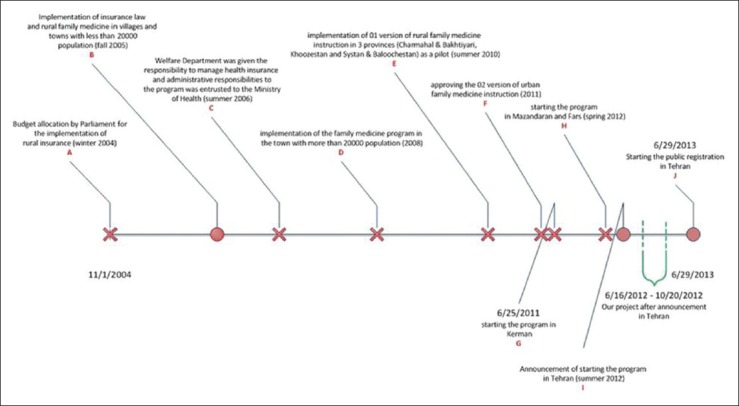
Timeline of family medicine program in Iran and Tehran
Since more than three decades ago primary health care was the base of Health care delivery systems and family physicians were the most active health care providers in developed countries.[17,18,19] After establishment of Primary Health Care (PHC) and integration of medical education in former Iranian ministry of health and formation of Ministry of Health and Medical Education (MOHME), implantation of family physician program in cities accounts for the third major health program after Islamic revolution in Iran.[17,18,19] Family physician program and the health referral system was one of the important steps of 4th and 5th “Five Year Development Plan” of Islamic Republic of Iran.[20]
Studies on rural family physician program in Iran disclosed substantial gains in preventive programs, especially in hindering problems related to chronic diseases, the most important concerns of public health these days[4,5] and environment health.[21,22] On the other hand, some studies have been performed on public awareness and attitudes about rural family physician program and the source of their information.[23,24] Researchers believed that since people's appropriate knowledge about public health programs is one the major factors to get more achievements, increasing educative programs are inevitable.[3,25,26,27]
MOHME planned to establish family physician program in Tehran after confirming the success of pilot programs. As a result, in summer 2012, Tehran inhabitants started to register officially and informative advertisements about the program were conducted through billboards and mass media (TV, Radio, Newspapers…).
The main objective of this study was to investigate whether these programs have been successful in informing people about the details or not; also we aimed to demonstrate public's attitudes about the future of family physician plan and their tendency to participate in it.
METHODS
This cross-sectional study was performed in Tehran during November to December 2012. Households from Tehran's residential areas were included in the survey through Random Digit Dialing (RDD) by means of within-household respondent selection method. Only one eligible person from each household was selected for the interview. When the random numbers dialed a house and absolutely after obtaining the consent to precede the conversation, the samples were being selected among all family members above 18 years old by the nearest birthday method.[28,29] The qualified member of the family whose birthday was the latest among all was invited to participate in telephone interview. Requirements for eligibility of calls included:
Belonging to residential areas
Not being faced with answering machines during calls
Existence of the qualified individual in the household members (18 years old or older without any physical or language barrier, alert and without any mental or physical problem inhibiting his/her proper participation in the survey able to communicate through phone).
Preparing survey instrument
First of all researchers reviewed all the guidelines about family physician program, published on behalf of MOHME. Afterwards two separate focus group discussions (FGD) were conducted around the points extracted from reviews and also to obtain group members ideas and their expectations from family physician program. Discussions groups included expert (consisted of members from Tehran Health policy Research Center, Community Based Participatory Research Center and Knowledge Utilization Research Center) and general population. FGDs were documented and recorded after obtaining participants informed consent. The discussions and guideline reviews resulted in a questionnaire which was supposed to be filled out by study participants in the next step of the study to measure their knowledge, attitude and practice about the program (Cronbach's alpha = 0.73 & ICC = 0.762).
Data gathering and data analysis
After preparing appropriate instruments we performed RDD method to choose study participants. We designed to ask all subjects one major question to find out their awareness about the program. in continue, those people who were aware about the program must have answer the rest of the questions as well so that we could measure their awareness level about family physician program, their attitudes towards the program and finally their tendency to participate in the program. According to the responses provided by individuals each person attributed a knowledge score of 0-27, this point for unaware persons also was attributed a zero knowledge score.
After data gathering process and scoring the participants, data analysis were performed by spss software version 17. The most important tests we utilized included: ANOVA, T-test and regression analysis.
RDD Sample size calculation
To compute study sample size a pilot study was conducted in compliance with all principles of RDD surveys. According to our pilot RDD study we needed 373 completed interviews. After computing in RDD sample size calculation formula, 20,000 randomly selected telephone numbers were extracted and dialed. The basis for calculation of the sample size is by considering the possible completed interviews divided by the product of expected values for the rate of residential numbers, eligible respondents and the rate of cooperation within dialed numbers. Detail of this formula is presented by the American Association of Public Opinion Research (AAPOR).[30,31,32]
Ethical considerations
This study was conducted in conformity with the Institutional Review Board (IRB) of Tehran University of Medical Sciences, which follows the Helsinki declaration on research ethics. Interviewers were given thorough instructions on the ethical principles of telephone surveys. Participants gave their verbal consent before starting the interview. Other ethical issues (including plagiarism, misconduct, data fabrication and/or falsification, double publication and/or submission, redundancy, etc) have been completely observed by the authors.
RESULTS
Demographic Information
Total of 386 questionnaires were completed by study participants. Among all samples 48% (185) of respondents were 18-35 and the rest were 35 and above. More than half of them were females (79.8% female and 20.2% males), 60% (231) were housewives and 33.1% (127) of them had academic educations.
Random digit dialing results
Considering the important principles of an unbiased RDD sampling, 386 questionnaires were completed by respondents. Among total contacted numbers we reached 1500(7.5%) defined numbers (actual telephone numbers), and only 52.6% (789) attributed to residential areas. Among those 789 telephone numbers 603 were eligible to perform the interviews also 148 rejected to interview or did not finish the interview (38 unfinished interviews). Thus, the interview rejection rate was almost 24.5%. The response rate as defined by the AAPOR criterions was 80%, cooperation rate was 54% and contact rate was 28%. Given Tehran's population, the margin of sampling error was 4.8% (95%confidence level) for 386 interviews, meaning that reported responses to survey questions if the entire population were to be polled were likely to fall within that range at that confidence level.[28,29,33,34,35]
Public knowledge, attitudes and practice about Family Physician Program
among all study participants 214 persons (57.4%) gave positive response to our major question, so for the other 159 participants (42.6%) family physician program was completely unknown. 49.1% of total participants (183 subjects) had some information about the project, however most of the answers were incorrect or even completely opposite. This means that some of the aware people also got a zero score and only 6.4% of the interviewees that answered the total questionnaire had somewhat reasonable information about the family physician project (knowledge score ≥10).
The main resource that people had obtained their information about family physician program was TV (78.8% of the people who knew the program); other informative resources included radio, newspapers, health providers, billboards, friends or coworkers. There was not any significant difference in average level of awareness among the groups of respondents with different source of information [Table 1].
Table 1.
The information resources among population
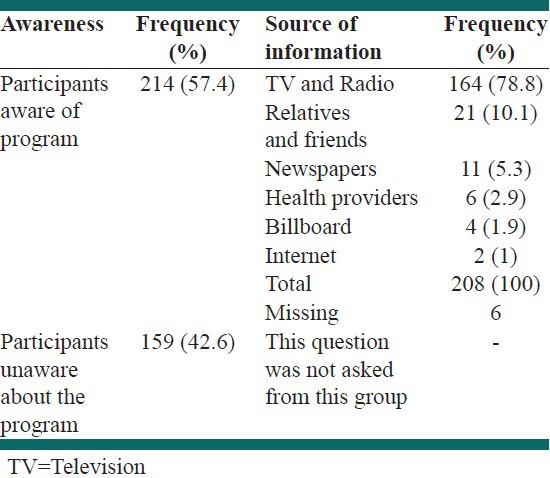
86.8% of people who had heard about the project (186 subjects) did not have any information about the ways to choose their family physician, 34.4% (74 subjects) were aware about the possibility of changing already attributed physician. Only 4.8% (91 subjects among 189) were aware about free of costs services which have been planned to be provide by family physicians. Only 14.9% of those who knew about implementation of the program had some information about the rule of referral system for treating by specialist.
2.5%(47 subject) of aware participants stated that they usually don’t see any kind of physician whenever they become sick, while 146 person(77.3%) chose general practitioners and the rest 36 (18.9%) preferred specialist doctors. 74.1% (141subjects) were planning to enroll in the program and the others 25.8% (49 people) preferred not to participate. Comparing two groups of aware people (those with and without willing to enroll was observed) we couldn’t find any mean difference between the average level of awareness between two groups.
Study participants were questioned about their intention to enroll in the program to receive family physician services. After responding to this question next time they should have demonstrated their degree of agreement with establishment of this program in Tehran. 141 subjects (74.6% of aware participants) were determined to enroll and participate in the program; amongst these people 85.1% (120 subjects) confirmed family physician program as a helpful program in health promotion in a city like Tehran. On the other hand among those people who were in hesitation about participation in the program 52.1% (25 subjects) believed that a successful family physician program improves the quality of medical services [Table 2].
Table 2.
Participants’ opinion toward family physician program considering their intention to participate in the program
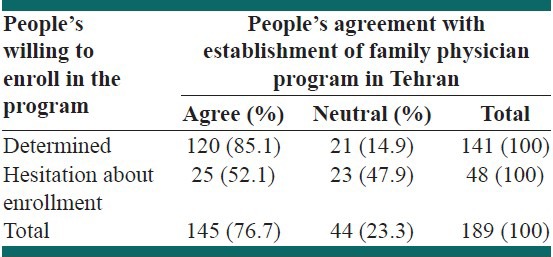
Participants expressed their positive or negative ideas about the implementation of the family physician program in Tehran which was mostly based on their views about the experience of this program in other countries Table 3 shows people's positive and negative believes about the future of the family physician program in Iran. The point here is that the positive opinions were based on what people already have seen or heard about family physician program in other countries.
Table 3.
Participants’ positive and negative beliefs about the future of the family physician program

After designing the causal DAG for variables which could have influence on person's agreement or disagreement with implementation of family physician program in Tehran, linear and logistic regression resulted in two models. As demonstrated in Figure 2 in the first model participants’ awareness score had a significant positive influence on their agreement with the program. In second model subject's Educational level and socioeconomic status (SES), health insurance, also his/her access to internet were entered in logistic regression model. As brought in Table 4 after adjustment for other factors (Educational Status, SES, Access to Internet,) people without any type of health insurance were more likely to disagree with the implementation of family physician program in Tehran.
Figure 2.
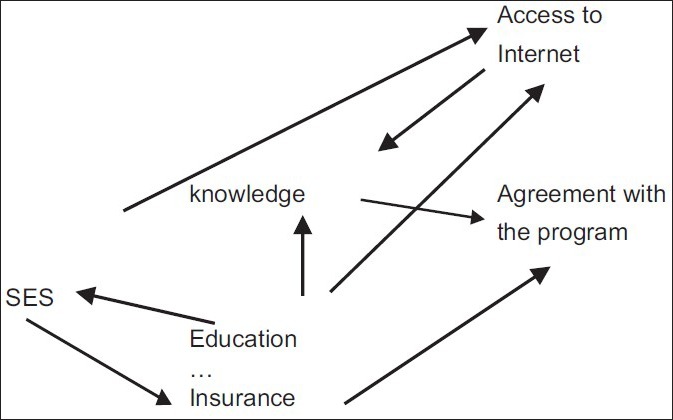
Directed acyclic graph for the factors influencing people's agreement level with family physician program
Table 4.
Effective factors on person's agreement with establishment of family physician program
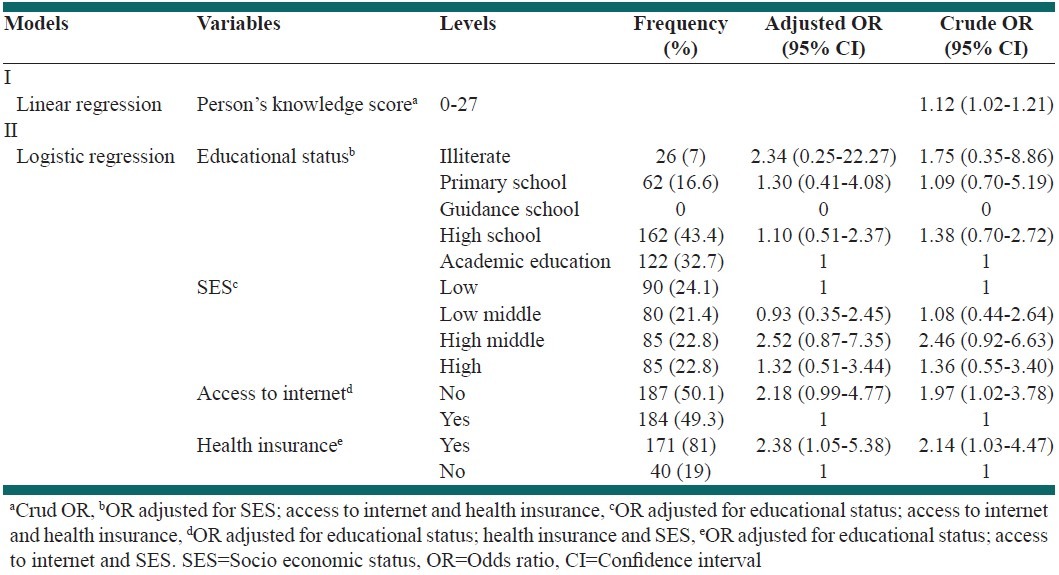
DISCUSSION
Our survey emphasizes that to achieve successful results from family physician program in cities in an Iranian community we need to increase public awareness about details and objectives of family physician program. Enhanced awareness can appeal people's trust towards family physicians and consequently encourage their active collaboration in this program. We identified two important factors that enhance people's agreement with establishment of family physician program and consequently their intension to participate in the program including: awareness score (OR=1.12(1.02-1.21)) and owning health insurance (OR=2.38(1.05-5.38)). Even though we can infer that those whose health expenses are paid via insurance companies can trust in preparing appropriate health services by another network like family physician program, still the fact that already insured people are more likely to agree with the program reveals a knowledge deficiency among population.
In a recent survey about rural family physician program in Iran, social workers were the most important source to inform people about the program and they had moderate awareness[36]. Our study demonstrated that the major resource which people received their information - although insignificant - about the family physician program was Television. Television was the most informative resource, but unfortunately those people- who had been informed through Television also had very low levels of awareness.
Previous studies also suggested that users’ awareness about newly established programs helps to obtain more desirable achievements. Specifically when users of family physicians services in rural regions did not have efficient knowledge about the conditions and benefits of family physician program's health coverage facility, they did not cooperate well in this program as well.[26,27] Current research showed that people who already had health coverage more than others were in favor of the establishment of this program (OR=2.38(1.05-5.38)). Also our findings underlines the importance of public awareness on their tendency to participate in the program (OR=1.12(1.02-1.21)).
Lack of enough mutual trust in telephone surveys is an important issue because communications do not happen face-to-face. Specifically as a result of coincidence of current survey with recently raised arguments about possible changes in allocation of subsidies to families, people seemed to be reluctant in revealing their real health assurance condition, socioeconomic status and so on. For this reason in every interview it took a while to gain respondents confidence. Interviewers were completely instructed to perform the interviews according to guidelines especially when they confronted with individuals who rejected to interview or wanted to terminate their interviews before finishing it.
To our surprise even though there were various advertisements to inform people about family physician program, around half of the participants did not have any information about this program. Also interestingly those people who knew about the program had only slight information.
A substantial contrast which we found in this survey is that despite their poor awareness about details of family physician program most of people planned to participate in the program (63.5% of already aware population). It seems that even partial information about an ongoing health promotion program, is effective to draw people's attention and encourage their participation in the program. As previously brought in results almost half of the participants did not have any information about family physician program; in this condition more innovative methods to enhance the awareness is required.
An important point in our results is the public concerns about abandoning the program after a while even before its complete implementation. They were disappointed that it would end in failure since they have already witnessed major national projects that had imposed high costs on society but never resulted in desirable achievements. On the other side, the optimist participants in stating their agreement implicitly indicated that their beliefs were mostly based on what they have heard or seen about other countries successful experiences in family physician.
Based on CBPR1 principles, in order to meet the objectives of an extensive health program, it is crucial to enhance community participation. As above mentioned, most of the study participants didn’t have any idea about this program and its advantages for the community. To achieve successful results in family physician program it seems that providing effective instructive programs to clarify the objectives and details of this program can help people to feel ownership in this context.[23,25,36,37]
CONCLUSIONS
As we know for implementation of a complicated task like family physician program, which requires a broad-based support and involvement, establishing a decentralized2 network would be appropriate. Since Television was the most dominant source for informing public about family physician program, providing informative programs about the objectives and details of the family physician may terminate totally idealistic or pessimistic opinions among community. In addition to the information channel, during the transferring a message its quality and quantity like being concise, interesting and usefulness also should be considered. The program administrators must focus on other information channels besides Television. The question is whether or not the programs were efficiently sufficient or the problem is that the people were not interested in receiving information about new project?
ACKNOWLEDGEMENT
The authors wish to express thanks to all of the participants in this study. This research has been supported by Tehran University of Medical Sciences grant No. 91-03-62-19652. The authors declare that there is no conflict of interest.
Footnotes
Community Based Participatory Research
Decentralized network means that all members are present when the information is transmitted and discussed (Forsyth, 1999)
Source of Support: This research has been supported by Tehran University of Medical Sciences Grant No. 91-03-62-19652
Conflict of Interest: None declared.
REFERENCES
- 1.Janati A, MalekI MR, Gholizadeh M, Narimani MR, Vakeli S. Assessing the strengths & weaknesses of family physician program. Knowl Health. 2010;4:39–44. [Google Scholar]
- 2.Takian A, Doshmangir L, Rashidian A. Implementing family physician programme in rural Iran: Exploring the role of an existing primary health care network. Fam Pract. 2013;30:551–9. doi: 10.1093/fampra/cmt025. [DOI] [PubMed] [Google Scholar]
- 3.Shariati M, Rahbar MR, Kazemeini H, Mirmohammadkhani M, Emamian MH. Family physician in the health care system in 1404 Map of Iran (a report in persian) 1389 [Google Scholar]
- 4.Center IIPR. the Forth Five Year Development Plan of the Islamic Republic of Iran. Iranian Islamic Parliament Research Center (Majlis Research Center) 2008 [Google Scholar]
- 5.Center IIPR. The Fifth Five Year Development Plan of the Islamic Republic of Iran. Iranian Islamic Parliament Research Center (Majlis Research Center) 2011 [Google Scholar]
- 6.Family physician program began in Tehran (in persian) Edition. [Last accesed on 2012 Jun 28]. Available from: http://www.mardomsalari. com .
- 7.Implementing the Family Physician Program in Tehran. [Last accesed on 2012 Jun 26];Edition News analysis website Asr-e Iran. [Google Scholar]
- 8.Begining of Family Physician Program in Tehran (in Persian) Edition 24. [Last accesed on 2012 Jul 17]. Available from: http://www.onlinenews.ir .
- 9.Family Physician Program begins in Government Week in Kerman (in persian) Family Physicians, Health Team Communication Network Edition. [Last accesed on 2012 Jul 10]. Available from: http://www.Familyph.ir .
- 10.Version 02 Family Physicians’ Guidelines. [Last accesed on 2013 Apr 23];Edition Fars News: Social Group/Health Care Section. [Google Scholar]
- 11.Family Physician Program is a Major Change in the Iran Health Sector (in persian) Edition. Iran Health Insurance Organization-Kerman HQ. [Last accesed on 2008 Feb 25]. Available from: http://www.bimeh.kr.ir .
- 12.Dastjerdi visited the implementing of family physician program in three provinces of Iran (in persian) Edition. Mehr News. [Last accesed on 2010 Aug 10]. Available from: http://www.ghatreh.com .
- 13.Shariati M, Rahbar MR, Hosein K, Khani Majid MM, Hosein EM. Edition Iran National Institute for Health Research; 2011. Family physician in the 1404 health care system Map of Iran (in persian) [Google Scholar]
- 14.Babak AG. Family physician a failed plan in Iran? (in persian) [Last accesed on 2009 Feb 24];pezeshk2iran, Edition Iran. [Google Scholar]
- 15.Gol Alizadeh E. Publish the result of family physician program/why it was failed? (in persian) [Last accesed on 2013 Jul 27];Edition News analysis website Asr-e Iran (in persian) [Google Scholar]
- 16.Looking at the implementing of family physician project in Iran and three successful countries in the world (in persian) [Last accesed on 2013 Feb 13];Ebtekar Edition (Iran Morning Newspaper) [Google Scholar]
- 17.Services NH. The NHS in England. Services, N.H. 2013 [Google Scholar]
- 18.Canada H. Canada's Health Care System (Medicare) Health Canada. 2010 [Google Scholar]
- 19.Rodwin VG. The health care system under French national health insurance: Lessons for health reform in the United States. Am J Public Health. 2003;93:31–7. doi: 10.2105/ajph.93.1.31. [DOI] [PMC free article] [PubMed] [Google Scholar]
- 20.Majdzadeh R. Family physician implementation and preventive medicine; opportunities and challenges. Int J Prev Med. 2012;3:665–9. [PMC free article] [PubMed] [Google Scholar]
- 21.Jabbari H, Yaaghoubi AR, Bakhshian F. 6th National Conference on Environmental Health Center - November 2013. Edition Tabtiz University of Medical Sciences; 2013. Performance of health centers in health management, drinking water before and after implementation of the family physician. [Google Scholar]
- 22.Jabbari H, Yaaghoubi AR, Bakhshian F, Ebadi H. 6th National Conference on Environmental Health Center - November 2013. Edition Tabtiz University of Medical Sciences; 2013. realization of the principles of Public participation and cooperation in the field of environmental health services before and after the implementation of the family physician. [Google Scholar]
- 23.Rouhi N. Evaluate the impacts of family physicians on indices of diabetes diabetes in rural population over 80 years on Quochan city 2011-2012 (Poster in persian) Proceedings of the Seminar on the Role of Family Doctors in the Health System. 2012 [Google Scholar]
- 24.Sepanlou SG, Kamangar F, Poustchi H, Malekzadeh R. Reducing the burden of chronic diseases: A neglected agenda in Iranian health care system, requiring a plan for action. Arch Iran Med. 2010;13:340–50. [PubMed] [Google Scholar]
- 25.Rahim-khanli E, Mohammad-karimi S, Mosallanejad H. Public awareness and satisfaction about family physician program, 2010 (in persian) Proceedings of the Seminar on the Role of Family Physicians in Health Systems. 2011:14. [Google Scholar]
- 26.Motlagh ME, Nasrollahpour SD, Ashrafian H, Kabir MJ, Nahvijooy A, Moaudi S. Familiarity of rural people engaged in rural assurance towards principles, facilities, and conditions of rural assurance in family physician (FP) program in northern provinces of Iran - 2008. J N Khorasan Univ Med Sci. 2010;2:33–8. [Google Scholar]
- 27.Alidoosti M, Tavassoli E, Raeisi M. Association between knowledge and reasons to chose family physician program in rural regions of Shahr-e-Kord (paper in persian) 8th Congress of Medical Sciences Universities of West of the Iran. 2013:1. [Google Scholar]
- 28.Kennedy C, Keeter S, Dimock M. A “brute force” estimation of the residency rate for undetermined telephone numbers in an RDD survey. Public Opin Q. 2008;72:28–39. [Google Scholar]
- 29.Glaser SL, Stearns CB. Reliability of random digit dialing calls to enumerate an adult female population. Am J Epidemiol. 2002;155:972–5. doi: 10.1093/aje/155.10.972. [DOI] [PubMed] [Google Scholar]
- 30.AAPOR. Margin of Sampling Error. American Association for Public Opinion Research. 2007 [Google Scholar]
- 31.AAPOR. The Code of Professional Ethics and Practices American Association for Public Opinion Research. 2010 [Google Scholar]
- 32.Casady RJ. Telephone Survey Designs U.S. Bureau of Labor Statistics. 1989:27. ERIC Number: ED312292. [Google Scholar]
- 33.Rizzo L, Brick JM, Park I. A minimally intrusive method for sampling persons in random digit dial surveys. Public Opin Q. 2004;68:267–74. [Google Scholar]
- 34.Gaziano C. Comparative analysis of within-household respondent selection techniques. Public Opin Q. 2005;69:124–57. [Google Scholar]
- 35.Johnson BB. Experience with urban air pollution in Paterson, New Jersey and implications for air pollution communication. Risk Anal. 2012;32:39–53. doi: 10.1111/j.1539-6924.2011.01669.x. [DOI] [PubMed] [Google Scholar]
- 36.Tvassoli EA, Masoomeh A, Kadivi R, Sharifirad GR, Hasanzadeh A. Relationship between knowledge and attitudes of rural people with information resources about family physician program in Shahr-e-Kord, 2010. Health Syst Res. 2010;6:498–505. [Google Scholar]
- 37.Alidoosti M, Tavassoli E, Khadivi R, Sharifirad GH. A survey on knowledge and attitudes of rurals population towards the family physician program in Shahr-e-kord city. Health Inf Manage. 2011;(Special Issue):635–29. [Google Scholar]


